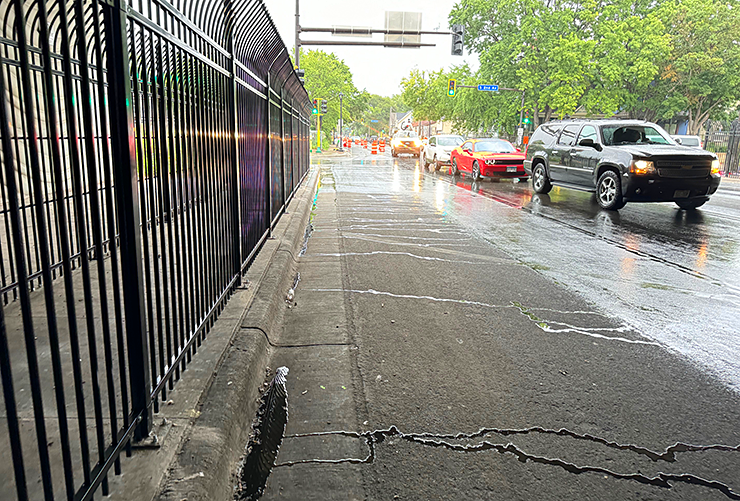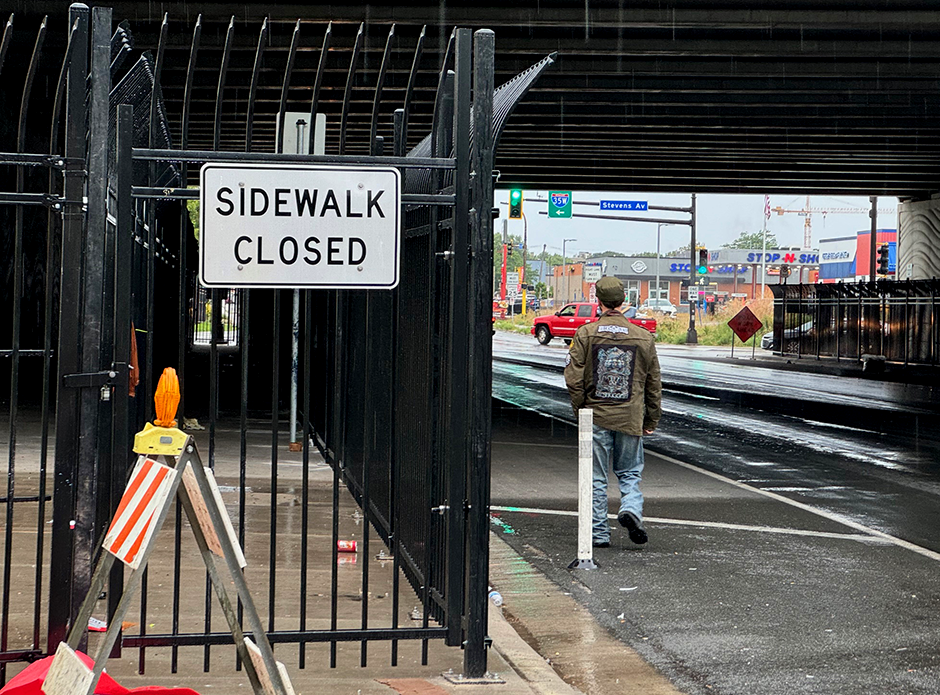Walking north down 3rd Avenue South toward the corner of East 31st Street in south Minneapolis, a pedestrian detour sign points foot traffic west down 31st Street. But you can’t walk far, at least not legally. A massive gate meets foot traffic looking to cross under the Interstate 35W overpass.
Why is it there?
The Minnesota Department of Transportation (MnDOT) evicted an encampment under the 35W bridge on 31st Street in early August. MnDOT has jurisdiction over the infrastructure under expressway overpasses. Shortly after the eviction, a fence was erected around the sidewalk to prevent future camps.
A MnDOT spokesperson sent this statement to MinnPost regarding the fence: “Highway right-of-way and roadways are not safe places for human beings to live and be and for safety reasons fencing needed to be installed in this location.”
MnDOT coordinated with service providers and state and county partners to provide information, support and alternatives to people at the site including the Hennepin County Streets to Housing team, according to the statement.
While they didn’t want to be quoted by name in this story, several people walking around the area near the fence on a recent afternoon said they didn’t feel comfortable walking through the area before the fence was erected either because so many people and tents were under the overpass.
There are anywhere between 300 to 500 unhoused people living outside in Hennepin county, said Daniel Weckman, outreach manager for local nonprofit Twin Cities Recovery Project.
For organizations working with the city’s unhoused population, displacements like the one in August force groups to start over in building relationships and finding resources for the affected people, Weckman said.
“Every time they do one of these breakdown-and-moves, somebody gets retraumatized and we have to go and start over, find them all over again and try to find these resources for the individual,” he said.
Dispersing camps doesn’t fix the problems preventing people living outside from finding shelter, Weckman noted. Instead, most move on to the next place. In the case of those who moved from the 35W overpass, many moved to spaces around the former Kmart site at Lake Street and 1st Avenue South and around the intersection of Stevens Avenue and East Lake Street. However, the Twin Cities Recovery Project hasn’t located all who’d been identified as living under the overpass.
Often when a camp is dispersed, people spread out. It usually takes at least a week for people to congregate again, Weckman said.
“I’m just hoping that when we do find them we find the people we’re looking for,” Weckman said.

Twin Cities Recovery Project serves as a daytime shelter. People can come to the nonprofit’s offices at 3400 East Lake Street in south Minneapolis and 1011 West Broadway in north Minneapolis from 9 a.m. to 5 p.m. The center distributes donations of food and clothing it collects to people in need who show up.
Outside of Twin Cities Recovery Project, Weckman said people seeking shelter can use a program called Adult Shelter Connect, which aims to give access to every open bed in Hennepin County and Ramsey County.
Long term, Weckman said a permanent solution is needed.
“We can’t keep having these small encampments and breaking them down and moving people, breaking them down and moving people. We need a brick-and-mortar solution,” he said.

Winter Keefer
Winter Keefer is MinnPost’s Metro reporter. Follow her on Twitter or email her at wkeefer@minnpost.com.





